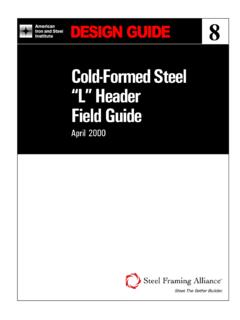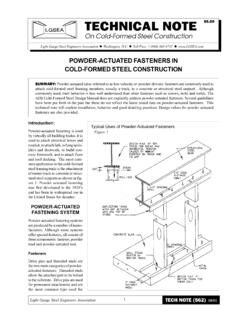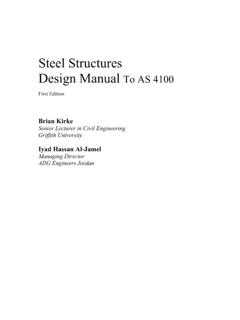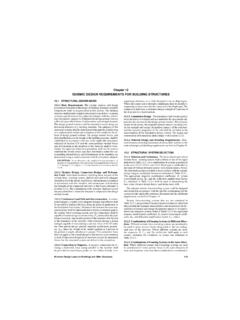Transcription of North American Specification for the Design of Cold-Formed ...
1 AISI S100-16 A I S I S T A N D A R D North American Specification for the Design of Cold-Formed Steel Structural Members 2016 Edition Approved in Canada by CSA Group Endorsed in Mexico by CANACERO AISI S100-16 Approved in Canada by CSA Group Endorsed in Mexico by CANACERO AISI STANDARD North American Specification for the Design of Cold-Formed Steel Structural Members 2016 EDITION ii AISI S100-16 DISCLAIMER The material contained herein has been developed by a joint effort of the American Iron and Steel Institute (AISI) Committee on Specifications, CSA Group Technical Committee on Cold Formed Steel Structural Members (S136), and Camara Nacional de la Industria del Hierro y del Acero (CANACERO) in Mexico.
2 The organizations and the Committees have made a diligent effort to present accurate, reliable, and useful information on Cold-Formed steel Design . The Committees acknowledge and are grateful for the contributions of the numerous researchers, engineers, and others who have contributed to the body of knowledge on the subject. Specific references are included in the Commentary on the Specification . With anticipated improvements in understanding of the behavior of Cold-Formed steel and the continuing development of new technology, this material may eventually become dated.
3 It is anticipated that future editions of this Specification will update this material as new information becomes available, but this cannot be guaranteed. The materials set forth herein are for general information only. They are not a substitute for competent professional advice. Application of this information to a specific project should be reviewed by a registered professional engineer. Indeed, in most jurisdictions, such review is required by law. Anyone making use of the information set forth herein does so at their own risk and assumes any and all resulting liability arising therefrom.
4 1st Printing October 2016 Produced by American Iron and Steel Institute Copyright American Iron and Steel Institute and CSA Group 2016 This document is copyrighted by AISI. Any redistribution is American Specification for the Design of Cold-Formed Steel Structural Members, 2016 Edition iii DEDICATION This edition of AISI S100 is dedicated to Roger L. Brockenbrough, , who served as chairman of the AISI Committee on Specifications from 1991 to 2016. Roger led the development of the first unified ASD and LRFD steel Design Specification , as well as the first harmonized North American Cold-Formed Steel Specification .
5 The Direct Strength Method was introduced under his leadership, and is incorporated into the main body of this edition of AISI S100. The Committee recognizes his significant contributions to the development of AISI S100, AISI S310, AISI test standards, and AISI Design guides and manuals. The members of the AISI Committee on Specifications have valued Roger s open-minded leadership approach and his willingness to promote new ideas and suggestions. Roger has been instrumental in the successes of the Committee on Specifications. The staff and members of AISI, along with the members of the Committee, greatly appreciate his dedication and contributions toward advancing the Cold-Formed steel industry.
6 This document is copyrighted by AISI. Any redistribution is AISI S100-16 This Page is Intentionally Left Blank. This document is copyrighted by AISI. Any redistribution is American Specification for the Design of Cold-Formed Steel Structural Members, 2016 Edition v PREFACE The North American Specification for the Design of Cold-Formed Steel Structural Members, as its name implies, is intended for use throughout Canada, Mexico, and the United States. This Specification supersedes the 2012 and previous editions of the North American Cold-Formed Steel Specification , the previous editions of the Specification for the Design of Cold-Formed Steel Structural Members published by the American Iron and Steel Institute (AISI), and the previous editions of CSA Group S136, Cold Formed Steel Structural Members, published by CSA Group.
7 The Specification was developed by a joint effort of the American Iron and Steel Institute Committee on Specifications, CSA Group Technical Committee on Cold Formed Steel Structural Members (S136), and Camara Nacional de la Industria del Hierro y del Acero (CANACERO) in Mexico. This effort was coordinated through the North American Specification Committee, which was made up of members from the AISI Committee on Specifications and the CSA Group S136 Committee. Since the Specification is intended for use in Canada, Mexico, and the United States, it was necessary to develop a format that would allow for requirements particular to each country.
8 This resulted in a main document, Chapters A through M and Appendices 1 and 2, that is intended for use in all three countries, and two country-specific appendices (A and B). Appendix A is for use in both the United States and Mexico, and Appendix B is for use in Canada. A symbol ( A,B ) is used in the main document to point out that additional provisions are provided in the corresponding appendices indicated by the letters. This Specification provides an integrated treatment of Allowable Strength Design (ASD), Load and resistance Factor Design (LRFD), and Limit States Design (LSD).
9 This is accomplished by including the appropriate resistance factors (f) for use with LRFD and LSD and the appropriate safety factors ( ) for use with ASD. It should be noted that the use of LSD is limited to Canada and the use of ASD and LRFD is limited to the United States and Mexico. The Specification also contains some terminology that is defined differently in Canada, the United States, and Mexico. These differences are set out in Section , Definitions. In the Specification , the terms that are specifically applicable to LSD are included in square brackets. The Specification provides well-defined procedures for the Design of load-carrying Cold-Formed steel members in buildings, as well as other applications, provided that proper allowances are made for dynamic effects.
10 The provisions reflect the results of continuing research to develop new and improved information on the structural behavior of Cold-Formed steel members. The success of these efforts is evident in the wide acceptance of the previous editions of the Specification . The AISI and CSA Group consensus committees responsible for developing these provisions provide a balanced forum, with representatives of steel producers, fabricators, users, educators, researchers, and building code regulators. They are composed of engineers with a wide range of experience and high professional standing from throughout Canada and the United States.






